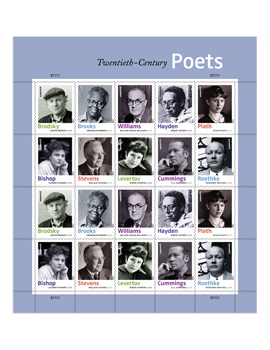I like my postal experience to be complete—buying the stamps at the window (and making the postal clerk show me every choice), addressing envelopes at home, and then walking across the street to the mailbox or going to the post office. Unfortunately my local post office is trying to drive me to web for the purchasing of stamps when they give me a choice of flags or flags. I'm going to try to get them in person and if that fails, I'll be going to the USPS website.
Here's what the website says about the stamps:
Ten great poets are honored on this Twentieth-Century Poets (Forever®) stamp sheet, including several who served as United States Poet Laureate. The many awards won by this illustrious group — Elizabeth Bishop, Joseph Brodsky, Gwendolyn Brooks, E. E. Cummings, Robert Hayden, Denise Levertov, Sylvia Plath, Theodore Roethke, Wallace Stevens, and William Carlos Williams — include numerous Pulitzer Prizes, National Book Awards, and honorary degrees.
Elizabeth Bishop (1911-1979) polished her poems to gleaming perfection, displaying the precise observation, intellectual strength, and understated humor that continue to win readers. Her poems walk the line between the marvelous and the ordinary and other contradictions.
Joseph Brodsky (1940-1996) was an exile from the Soviet Union who became the first foreign-born poet to be appointed Poet Laureate of the United States. Although he embraced the country he came to call home, many of his poems resonate with loneliness and loss.
Gwendolyn Brooks (1917-2000), another former U.S. Poet Laureate, is best remembered for distinctive, lyrical portraits of urban life. A master of traditional poetic forms, she also experimented with free verse, jazz and blues poetry, and colloquial language.
E. E. Cummings (1894-1962) expertly manipulated the rules of grammar, punctuation, rhyme, and meter to create poems that resembled modernist paintings. His works transformed notions of what a poem can do and delighted readers of all ages.
The poems of Robert Hayden (1913-1980) reflect his brilliant craftsmanship, his historical conscience, and his gift for storytelling. Many of his works render aspects of the black American experience with unforgettable vividness; others are more personal.
Denise Levertov (1923-1997) hoped her poetry would inspire change. Weaving together public and private, active and contemplative, she perfected an organic form of poetry that explored the political and social world through the intimate experiences and perceptions of the individual.
Sylvia Plath (1932-1963) probed the conflict between self and outward appearance. Her complex body of work includes deftly imagined poems about marriage and motherhood, gender and power, death and resurrection, and the sweet, enjoyable moments of everyday life.
Theodore Roethke (1908-1963) created intimate, introspective poems distinguished by lyricism and a sensual use of imagery. Best known for his poems about the natural world, he was profoundly influenced by the events of his childhood and mined his past for the themes and subjects of his writing.
The work of Wallace Stevens (1879-1955) presents a luxurious banquet of language and meaning. Many of his poems — some highly comic, others somber and spare — explore the relationship between consciousness and reality.
William Carlos Williams (1883-1963) was a doctor who typed out his poems between seeing patients. His work showed readers the extraordinary in the commonplace — a broken bottle, a red wheelbarrow left out in the rain — in deliberately plain language.
Art director and stamp designer Derry Noyes selected the photographs used in the stamp art. The photograph of Elizabeth Bishop was taken in Key West, Florida, by Josef Breitenbach. The photograph of Joseph Brodsky was taken in New York City by Nancy Crampton. The photograph of Gwendolyn Brooks was taken in Chicago in 1987 by Jon Randolph.
The photograph of E. E. Cummings was taken in 1935 by Edward Weston. The photograph of Robert Hayden was taken around 1975 by Timothy D. Franklin. The photograph of Denise Levertov was taken by Rollie McKenna. The photograph of Sylvia Plath was also taken by Rollie McKenna.
The photograph of Theodore Roethke was taken in London, England. The photograph of Wallace Stevens was taken by Sylvia Salmi. The photograph of William Carlos Williams was taken in the 1940s.
The sheet's verso includes an excerpt from one poem by each of the poets featured on the sheet.
Subscribe to:
Post Comments (Atom)






No comments:
Post a Comment